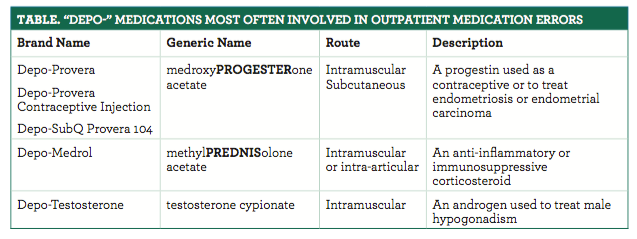Publication
Article
Pharmacy Times
"Depo-" Medications: Not a Depot for Errors
Author(s):
Several medications are available on the market with names that begin with “Depo-,” meaning they are administered via a depot injection that deposits the drug into localized tissue from which it is gradually absorbed by surrounding tissue.
Several medications are available on the market with names that begin with “Depo-,” meaning they are administered via a depot injection that deposits the drug into localized tissue from which it is gradually absorbed by surrounding tissue. These injections, typically subcutaneous, intramuscular, or intra-articular, allow the active compound to be released consistently over a longer period of time. Many of these Depo- medications have been on the market for 30 to 50 years, some even longer.
Misadministration of these medications and confusing one Depo- medication with another has been consistently reported throughout the years. More recently, mix-ups between different strengths and volumes of containers of a Depo- drug have occurred. The Depo- medications most often involved in outpatient errors (wrong route, wrong drug, wrong strength/volume) are listed in the table.
In 1 case reported to the Institute for Safe Medication Practices, a 19-year-old woman went to a clinic to receive an injection of Depo-Provera for contraception, which was to be repeated every 12 weeks. After providing a negative pregnancy test result, the young woman was mistakenly given an intramuscular injection of Depo-Medrol and the lot number of the vial of medication was recorded in her medical record. The woman returned in 12 weeks and reported a positive home pregnancy test result. An ultrasound confirmed the pregnancy, with an estimated date of conception about 3.5 weeks after her first injection. The error was uncovered when the documented lot number was found to be associated with Depo-Medrol.
In this case, Depo-Medrol and Depo-Provera had previously been stored in separate cabinets. However, a few days before the event, the medication cabinets had been consolidated, and the medications were stored alphabetically in bins. The stock in the consolidated cabinet had been labeled with Depo-Provera and Depo-Medrol, which were stored next to each other. Working with only a verbal order for the drug, the clinic staff had accidentally selected a vial of Depo-Medrol instead of the intended Depo-Provera.
Although manufacturers and regulatory agencies have improved the packaging and labeling of these products, health care practitioners can take steps to reduce the risk of potentially harmful mix-ups between these medications, strengths/container volumes, and routes of administration:
• Separate the storage of the Depo- medication vials in the pharmacy and in all clinical settings. In addition, store only 1 medication in each bin or other storage container and evaluate whether all of these drugs need to be stocked in patient care areas. Also, attempt to limit inventory of Depo-Testosterone to a single strength and vial size.
• Consider stocking Depo-Provera in prefilled syringes for single-patient use instead of single-dose vials. Because Depo-Medrol is not supplied in prefilled syringes, this may increase differentiation between the 2 products, but only if staff members know to expect Depo-Provera in a syringe. Thus, staff awareness is a necessary component of this differentiation strategy.
• Highlight or circle important information on labels to draw attention to them or add an auxiliary label if necessary.
• Use tall-man letters when expressing the generic names of Depo-Medrol and Depo-Provera (ie, methylPREDNISolone, medroxyPROGESTERone) to prevent confusion. When expressing generic names for Depo-Medrol and SOLU-MEDROL (methylPREDNISolone sodium succinate), include the form of methylPREDNISolone (ie, acetate, sodium succinate) to help differentiate the drugs.

Dr. Gaunt is a medication safety analyst and the editor of ISMP Medication Safety Alert! Community/ Ambulatory Care Edition.







